
* The first-generation Hueys led to a series of twin-engine variants, the "Twinhueys". Further improved variants and updates followed, helping keep the Huey in service in the 21st century.
* In 1965, Bell had experimented with a single twin-engine Model 208 "Twin Delta" Huey prototype, which was a UH-1D fitted with a Continental XT67-T-1 engine module, consisting of two T72-T-2 turboshaft engines driving a common gearbox. This exercise was performed as an experiment using company funds.
In early 1968, Bell had discussions with the Canadian government and Pratt & Whitney Canada (PWC) that led to an agreement in 1969 to build a twin-engine version of the Model 205. Bell flew a UH-1D fitted with a new PWC "Twin Pac" engine, consisting of two of PWC's popular PT6 turbines driving a common gearbox, in 1969. This prototype led to the production "Twin Huey" or "Model 212 / UH-1N", essentially a UH-1H fitted with the PWC T400-CP-400 (PT6T-3) Twin Pac, providing a total of 1,140 kW (1,530 SHP). Each turbine of the Twin Pac could actually provide 670 kW (900 SHP), but the rotor system couldn't deal with 1,340 kW (1,800 SHP). However, in the event of a failure of one of the turbines, the remaining operational turbine could be run at its full 670 kW (900 SHP) output.
Bell began deliveries of the UH-1N to the US Air Force in 1970, which obtained 79 and used them for special operations. The US Navy and Marine Corps were particularly interested in the type, since the twin-engine configuration provided greater flight safety for overwater operations, and obtained a total of 221 by 1978. Marine UH-1Ns would gradually be fitted with countermeasures, infrared imager nose turrets, and other kit. Two standard Marine UH-1Ns were converted to "VH-1N" VIP transports, and six Model 212s were built new to this standard for the Corps as well.
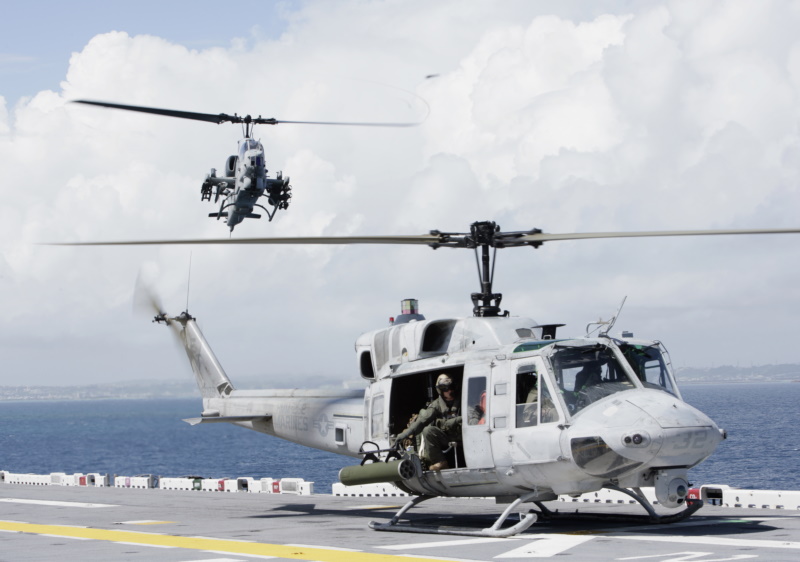
The USAF adopted the UH-1N for the crash rescue role as the "HH-1N", with about 52 machines fitted out much like the HH-1H. These machines were gradually replaced by the Leonardo MH-139 from 2021. The Marines also converted 38 UH-1Ns and 6 VH-1Ns to the HH-1N configuration for SAR use.
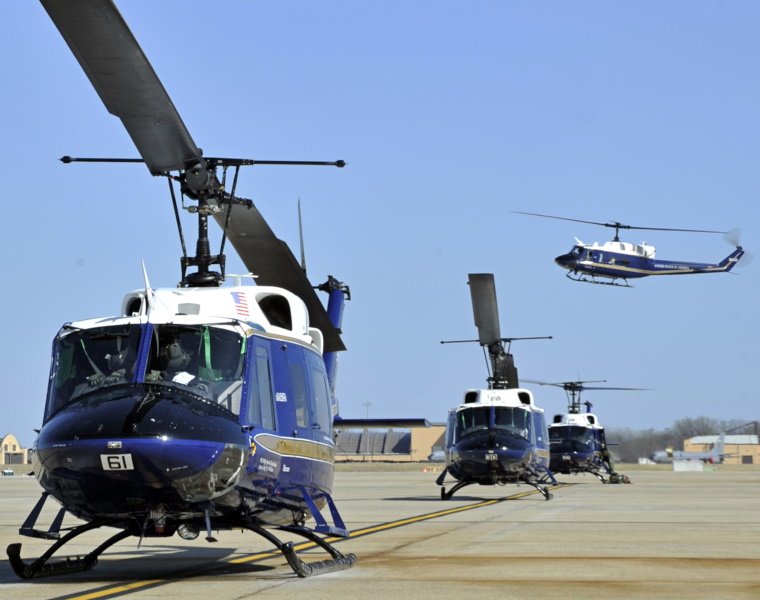
The Canadian Armed Forces, which had backed development of the type, received their first Model 212 on 3 May 1971, with the last of 50 delivered about a year later. The CAF originally designated the type the "CUH-1N", but this was later changed to "CH-135"; they were retired in the late 1990s, most of the survivors being bought up by the US and sent off to US allies. Small quantities of the Model 212 were sold to other military operators as well as commercial users. The enhanced safety provided by the Model 212's twin-engine configuration also proved to be an excellent selling point for commercial operators working in offshore gas and oil exploration. They are increasingly being retired, however.
___________________________________________________________________
BELL MODEL 212 / UH-1N TWIN HUEY:
___________________________________________________________________
rotor width:
14.69 meters (48 feet 2 inches)
footprint length:
17.46 meters (57 feet 3 inches)
fuselage length:
12.92 meters (42 feet 5 inches)
height:
4.53 meters (14 feet 10 inches)
empty weight:
2,720 kilograms (6,000 pounds)
max loaded weight:
4,535 kilograms (10,000 pounds)
maximum speed:
205 KPH (125 MPH / 110 KT)
service ceiling:
5,275 meters (17,300 feet)
range:
460 kilometers (285 MI / 250 NMI)
___________________________________________________________________
* The Bell "Model 412" program was announced on 8 September 1978, with initial deliveries in January 1981. It was essentially a Model 212 with a four-blade composite rotor for smoother and more efficient flight. The rotor system could be folded for compact storage. It was powered by a PWC PT6T-3B-1 Twin Pac engine providing a total of 977 kW (1,310 SHP). The Model 412 featured crashworthy seats, fuel tanks, and landing gear, and the fuselage also featured built-in maintenance steps and handholds to ease servicing in the field. It could carry up to 14 passengers, or six stretchers with attendants.

The initial 412 led to several improved variants:
Bell developed a prototype of an attack helicopter variant, the "Model 412AH", introduced in 1986. It featured a Lucas turret mounted under the nose fitted with a single 12.7-millimeter (0.50-caliber) machine gun, and could also carry rockets and other stores. Little seems to have come of this exercise.
___________________________________________________________________
BELL MODEL 412EP:
___________________________________________________________________
rotor width:
14.02 meters (46 feet)
footprint length:
17.12 meters (56 feet 2 inches)
fuselage length:
12.92 meters (42 feet 5 inches)
height:
3.48 meters (11 feet 5 inches)
empty weight:
3,100 kilograms (6,835 pounds)
max loaded weight:
5,400 kilograms (11,900 pounds)
maximum speed:
260 KPH (160 MPH / 140 KT)
hover ceiling:
3,100 meters (10,170 feet)
range:
745 kilometers (465 MI / 400 NMI)
___________________________________________________________________
Total sales by Bell of Model 412s amounted to some 530 by 1998. Model 412s were obtained, new or used, by governments and civil operators around the world. The Canadian Armed Forces were a big customer, buying 100 "CH-146 Griffons", which were Bell-built "Model 412CFs" with the PT6T-3D Twin Pac engine. 85 of them were upgraded from 2021 with an airframe service-life extension, engine updates, and new avionics.
Subaru of Japan -- previously Fuji Heavy Industries -- worked with Bell to develop an updated Model 412 variant, with the commercial designation of "412EPX". It was effectively a 412EPI with a new transmission that can run for a half hour without lubrication. Subaru went on to develop a version with military kit, initially the "UH-X" and later the "New Utility Helicopter (NUH)", with 150 to be built for the Japanese Ground Self-Defense Force, replacing the JGSDF UH-1J Huey. Initial flight of the NUH prototype was in late 2018, while initial service deliveries were in 2022. Both Subaru and Bell build the 412EPX and its variations.
BACK_TO_TOP* In 1970, Bell announced the introduction of an improved derivative of the Model 205 / UH-1H to be designated the "Model 214 Huey Plus". The single Model 214 prototype featured the Lycoming T53-L-13 turboshaft engine providing 1,044 kW (1,400 SHP); a new wide-chord "Nodomatic" rotor system with no teeter bar that could handle the full power of the engine; structural strengthening to permit higher load weights; and various detail changes.
The prototype led to the production "Model 214A", which was similar but had a much more powerful Lycoming LTC4B-8D turboshaft engine providing 2,186 kW (2,930 SHP). The Model 214A was demonstrated to the Iranians, and in late 1972 the Shah's government placed an order for 287 of the type for the Iranian Army, who named it the "Isfahan", after the town where the Iranian Army's helicopter training school was based. After this batch, the Iranian Army ordered six more Model 214As, while the Iranian Air Force ordered 39 Model 214Cs, which were similar but fitted for the SAR role. The Iranian Model 214s served in the country's war with Iraq in the 1980s.
* The Model 214A itself was basically a single-engine Model 212 and looked it, but Bell began to consider a "stretched" derivative with a "Twin Pac" type engine configuration and other much more visible changes. The company began discussions with the Shah's government for license production of the Model 214A and the new "Model 214ST (Stretched Twin)", but in 1979, the same year the first of three Model 214ST prototypes flew, the Shah's government was overthrown and the production scheme never happened.
Bell continued development of the Model 214ST anyway, rebadging the "ST" suffix to stand for "Super Transport", leading to initial deliveries of the new variant in 1982. The Model 214ST had a modernized and more streamlined appearance than other versions of the Huey; featured a "roll ring" built into the fuselage for crew protection; and was fitted with a glass-fiber rotor with titanium leading-edge strips and stainless steel end caps. It could carry a crew of two and up to 18 passengers.
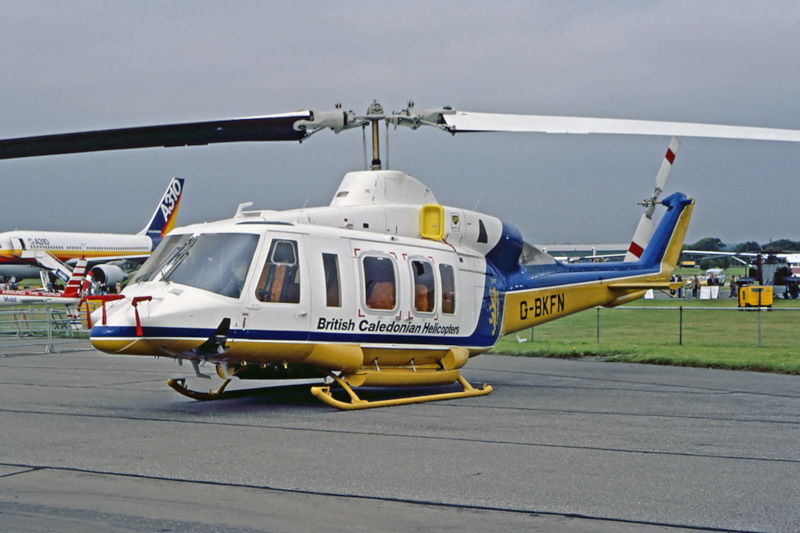
The Model 214ST was fitted with twin GE CT7 (T700) turbines providing a total of 2,424 kW (3,250 SHP), and could carry nearly 3,630 kilograms (8,000 pounds) of payload. It was fitted with an automatic rotor stabilization system that eliminated need for the classic Bell teeter bar. 96 were built to end of production in 1993.
The Model 214ST proved popular in commercial service, particularly for offshore oil and gas exploration, and was used by commercial services contracted to the US military, with a number ending up in the US State Department's Air Wing as well. It was also purchased by a number of foreign military services. The Iraqis bought 45 Model 214STs in the late 1980s, and small numbers were sold to Brunei, Oman, Peru, Venezuela, and Thailand. What happened to the Iraqi 214STs is not clear; it appears they didn't survive the First Gulf War.
___________________________________________________________________
BELL MODEL 214ST SUPER TRANSPORT:
___________________________________________________________________
rotor width:
15.85 meters (52 feet)
footprint length:
18.95 meters (65 feet 2 inches)
fuselage length:
15.02 meters (49 feet 4 inches)
height:
4.85 meters (15 feet 2 inches)
empty weight:
4,284 kilograms (9,445 pounds)
max loaded weight:
7,940 kilograms (17,500 pounds)
maximum speed:
255 KPH (160 MPH / 140 KT)
service ceiling:
1,950 meters (6,400 feet)
range:
800 kilometers (500 MI / 435 NMI)
___________________________________________________________________
* Bell also developed a civil derivative of the Model 214A, the "Model 214B BigLifter", with modest changes including emergency escape windows in the cargo doors, an engine fire extinguishing system, and civilian avionics. It was offered for roles such as passenger transport, a "flying crane" with an external cargo hook, agricultural service, or firefighter. The Model 214B was certified in early 1976, but there were few sales, with small numbers sold to Dubai, Ecuador, Oman, and the Philippines. Production ended in 1981. The Model 214 is gradually being retired.
BACK_TO_TOP* The Huey proved popular in foreign service. Bell sold small quantities of UH-1Bs and UH-1Ds to Australia and Norway, and UH-1Hs to Canada and New Zealand. The Canadians used their "CUH-1Hs" (later "CH-118") for training. At least 55 UH-1Hs were also shipped to Turkey.
However, most foreign-service Hueys were license-built. Dornier of Germany built 352 UH-1Ds for the West German Army; one was evaluated by the West German Army with pontoons. AIDC in Taiwan built 118 UH-1Hs for the Nationalist Chinese army. IPTN of Indonesia license-built the Model 412 as the "NBell-412".

Fuji Heavy Industries of Japan began license production of the Huey in 1962, producing at least 90 UH-1Bs and 50 UH-1Hs, mostly for the Japanese Self-Defense Forces but also for a few civil operators. Fuji then went on to develop a unique Japanese variant of the UH-1H, appropriately designated "UH-1J". The UH-1J featured an Allison T53-L-703 turboshaft engine providing 1,343 kW (1,800 SHP), a vibration-reduction system, infrared countermeasures, and a night-vision-goggle (NVG) compatible cockpit. First delivery of the UH-1J to the Self-Defense Forces was in 1993, with 128 built in all. As mentioned earlier the company, now Subaru, went on to work with Bell to develop the 412EPX / UH-X.
* The most enthusiastic alternate source for the Huey was Agusta of Italy. Agusta obtained a license to build Model 204 Hueys in 1961, flying their first example on 10 May 1961, and then went on to produce the Model 205. Agusta-Bell Model 204s and 205s were sold to a large number of nations, including Australia, Austria, Greece, Iran, Italy, Morocco, Oman, Saudi Arabia, Singapore, Spain, Sweden, Tanzania, Tunisia, Turkey, Yemen, Zambia, and Zimbabwe.
Agusta adopted a "customer is always right" attitude, and provided a wide range of auxiliary gear kits for customers. These kits included additional fuel tanks, rescue hoist, rotor brake, engine sand and dust filters, engine winterization, fixed floats, emergency flotation gear, snow skis, and a number of weapons fits. Agusta even supplied AB-204s fitted with a Rolls-Royce / Bristol Gnome H.1200 turboshaft providing 895 kW (1,200 SHP), or a GE T58-GE-2 turboshaft providing 988 kW (1,325 SHP) -- the Gnome, incidentally, being a British derivative of the T58. The company also developed prototypes of their own "Twin Hueys" based on AB-205s with dual Gnome H.1200 or Turbomeca Astazous engines, but these variants did not reach production.

The company built a specialized maritime warfare variant of the Huey designated the "AB-204AS" (where "AS" stood for "Anti-Submarine" or "Anti-Surface Vessel"), fitted with search radar, dunking sonar, and the capability to carry homing torpedoes and other stores for maritime combat. This machine was sold to the navies of Italy, Spain, and Turkey.
Italian Army AB205s were upgraded, primarily for service in Afghanistan. The upgrade featured an NVG-compatible cockpit; defensive countermeasures; ballistic protection; and avionics improvements, including updated communications, plus Doppler radar and a radar altimeter unit for night operations. They will be replaced by the AW169.
From 2010, Italian Army AB205s were upgraded for service in Afghanistan, with features including upgraded GPS navigation system, new radios, ballistic protection in the floor, armored seats, infrared exhaust suppressors, plus a defensive countermeasures suite. They were finally retired in late 2020. Other users are retiring them as well.
* Agusta went on to license-build the Bell 212, and sold the type to Austria, Dubai, Italy, Lebanon, Morocco, Saudi Arabia, Somalia, Spain, Sudan, Yemen, and Zambia.
As a follow-up to the AB-204AS, the company produced a similar ASW variant of the Model 212, the "AB-212AS". Work on this version began in 1971, resulting in the flight of a prototype in 1973. The AB-212AS resembled a standard Model 212 Twin Huey except for a prominent radome above the cockpit. Early production had a dome-shaped radome, while later production had a flatter "drum" radome, apparently reflecting different radar fits, with the later fit being the Ferranti SeaSpray radar. A winch outside the left side was standard equipment, used for handling the rotorcraft's Bendix ASQ-18 dipping sonar. Other changes included structural reinforcement, shipboard deck tiedown attachments, and corrosion protection.
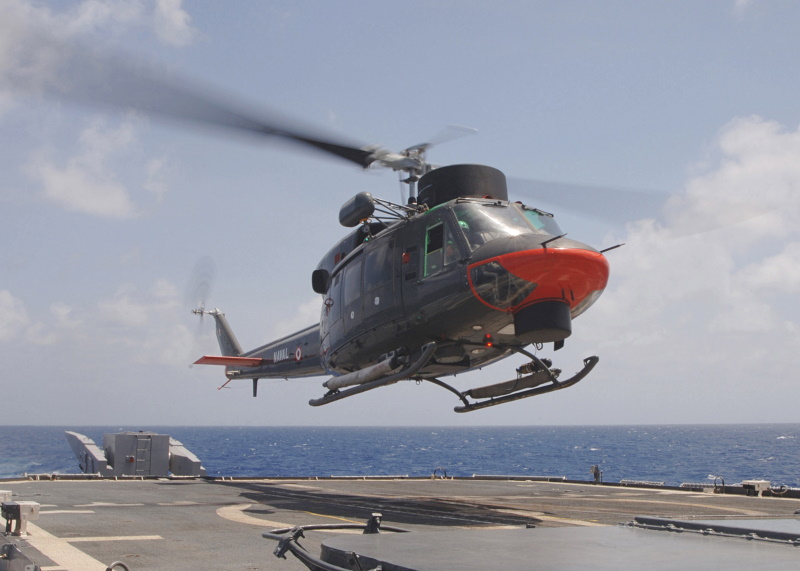
The AB-212AS carried a crew of four in maritime combat operations, including pilot, copilot, and two systems operators. It was fitted with an all-weather flight control system, which provided both navigation and "hands-off" autopilot capabilities, and was integrated with the helicopter's search and targeting systems to pinpoint both helicopter and target positions. The AB-212AS was also fitted with a defensive countermeasures suite.
In ASW operations, the AB-212AS could carry two Mk.44/46 or Moto Fides A-244/S homing torpedoes. For surface vessel attack operations, it could carry two Italian Marte Mk.2, British Sea Skua, or (now obsolete) Aerospatiale AS-12 light anti-ship missiles. The AB-212AS could also be fitted with a TG-2 Teseo data link to provide guidance updates to the Italian Otomat ship- or shore-launched antiship missile. Unarmed electronic-warfare configurations were sold as well.
Although the AB-212AS was optimized for the maritime combat mission, it retained the ability to carry passengers and cargo, as well as perform SAR missions using its winch. It could accommodate four litters and a medical attendant for medevac operation, or up to seven passengers. There was a coastal patrol / SAR configuration that had radar and searchlight, but no combat kit as such.
The AB-212AS was sold to Greece, Iran, Italy, Spain, Turkey, and Venezuela. Some were updated in service; Spain conducted an "AB-212+" upgrade program from 2013 that gave them a glass cockpit, new radar, and updated self-defense kit. AB-212s are gradually being retired.
* Agusta began production of the Model 412 in 1981, and quickly came up with a multi-role military version designated the "AB-412 Grifone (Griffon)", which could be fitted for gunship, medevac, troop transport, or SAR roles. First flight of the prototype Griffon was in 1982, with initial delivery in 1983.
The Grifone differed from the standard production Model 412 in having crash-resistant seats, adding armor plating for pilot and copilot; high-impact landing gear; self-sealing fuel tanks; and permanent armament attachment points. Optional sensor and countermeasures systems could be fitted. Possible weapons fits included two 12.7-millimeter gun pods; two 25-millimeter Oerlikon cannon; two 19-round launchers for 81-millimeter SNORA unguided rockets; four or eight TOW missiles; and air-to-air missile pods for Stinger and similar weapons. An AB-412ASW variant was offered with similar kit and configurations as the AB-212ASW, with variations for anti-surface warfare or SAR. The Grifone could carry six stretchers and two attendants, or up to 15 troops.
Grifones were obtained by Dubai, Finland, Italy, Lesotho, the Netherlands, Uganda, Uruguay, and Venezuela. Augusta production eventually moved on to the 412EP variant; presumably the Grifone is now based on that variant.
BACK_TO_TOP* With so many Hueys built, it is not surprising that several companies offered refurbishment and update programs. Bell offered a UH-1H update designated the "UH-1HP Huey II", which involved modifying the Lycoming T53-L-13 engine up to T53-L-703 standard, giving it 298 kW (400 SHP) more power for a total of 1,343 kW (1,800 SHP); a new dynamic system, derived from that of the UH-1N and the Model 212, to handle the greater power; new avionics; and airframe zero-lifing. The improved engine was more reliable, slightly more fuel efficient, and raised the payload from 450 kilograms (1,000 pounds) to 1,350 kilograms (3,000 pounds). Huey IIs have been obtained by Bolivia, Lebanon, US Customs, Kenya, Iraq, Uganda, and Yemen -- in some cases, being upgrades of Hueys already being flown by these users.
Global Helicopter offered a "Huey 800" update, which replaced the UH-1H's TF3-L-13 engine with an LHTEC T800-800 turboshaft. The new engine had the same power output as the old, meaning no dynamic system updates were required, but the new engine was lighter, more reliable, and much more fuel-efficient. UNC offered a "UH-1/T700" update very similar to the Bell UH-1HP update, but replaced the T53-L-703 engine with a GE T700-GE-701C engine with 1,413 kW (1,900 SHP) to provide improved fuel economy.
In 2004, Singapore Technologies Aerospace began delivery of 20 refurbished UH-1Hs to the Philippines. It appears these machines featured modest updates, including cockpit lighting compatible with NVGs.
* The US Marine Corps has kept their UH-1N Hueys up-to-date, adding countermeasures such as infrared jammers and chaff-flare dispensers, forward-looking infrared (FLIR) turrets in the nose, a cable cutter above the cockpit, new armament fits, and revised avionics. The service has now obtained an updated variant of the Huey, the "UH-1Y Super Huey" AKA "Venom", based on the UH-1N, intended to extend the service life of the UH-1Ns, and to improve payload and performance. The upgrade fit included:
The UH-1Y was stretched to accommodate the new hardware and preserve their center of balance. The Super Huey had 800 kilograms (1,760 kilograms) more payload capacity, and a top speed of 295 KPH (185 MPH) compared to a previous top speed of 200 KPH (125 MPH).

The first UH-1Y was rolled out in late 2001, with initial deliveries in 2008. Originally, the order envisioned that the Marines would obtain 100 UH-1Ys, all through upgrades of UH-1Ns, but the UH-1Ns were too heavily tasked in Iraq, Afghanistan, and elsewhere to be withdrawn from service for upgrade, and the price of new-build machines was only incrementally greater than that of rebuilt machines. The plan was changed to obtain 160 UH-1Ys, mostly new-build except, it seems, for ten upgrades from UH-1Ns for test and evaluation.
UH-1Ys in service are fitted with much the same kit as UH-1N, including sensor turrets, door guns, and 70-millimeter rocket pods. The 70-millimeter pods can also now carry the "Advanced Precision Kill Weapon System (APKWS)", which is a 70-millimeter rocket with a laser-guidance seeker module screwed in. This requires adding some wiring to the pod to support the seeker system. The APKWS also requires a laser target designator; it is unclear whether the UH-1Y can designate on its own through the sensor turret, or if it requires designation from another source. From 2016, the UH-1Y has also operationally carried the "AN/ALQ-31 Intrepid Tiger" communications jammer pod.
The original UH-1Y upgrade program was part of a deal that also involved a parallel upgrade of 180 Marine AH-1W SuperCobra helicopter gunships to the new "AH-1Z" standard, with a fair degree of commonality between the two updated aircraft. The last Marine UH-1Ns were retired in 2014, having been fully replaced by the UH-1Y; the last USMC HH-1Ns were retired a year later.
There have been export sales of the UH-1Y -- the first being Bosnia-Herzegovina, which bought four, the machines being delivered in 2021. That was followed by a sale of eight to the Czech Republic, which also obtained four AH-1Zs, deliveries of both being from 2023, with the US then providing two more UH-1Ys and six more AH-1Zs. There is plenty of life left in the old Huey yet.
* Hueys have been used for a number of research programs. One UH-1A was modified by Bell as a flying laboratory for new sensor and instrument configurations, and designated the "Research Helicopter 2 (RH-2)".
One of the YUH-1Bs was used as an aerodynamic test bed as the "Model 533" and modified to a number of configurations as part of a US Army program. The first series of modifications, flown in 1962, featured aerodynamic fairings, a new tail surface to offload the tail rotor, and a tilting rotor mast inside a large fairing structure. The Model 533 was then fitted with a swept wing, two Continental J69-T-29 turbojets with 7.55 kN (770 kgp / 1,700 lbf) thrust each, and a modified rotor blade with swept tips. This compound rotorcraft achieved a speed record of 370 KPH (236 MPH or 200 knots) in level flight on 15 October 1964, and on 6 April 1965 topped that record with a speed of 402 KPH (250 MPH) in level flight.

The Model 533 was finally fitted with two wingtip-mounted Pratt & Whitney JT12A-3 turbojets with 14.7 kN (1,500 kgp / 3,300 lbf) thrust each. In this configuration, it achieved speeds of over 480 KPH (300 MPH). At last notice, the Model 533 was on display at the US Army Transportation Museum at Fort Eustis, Virginia.
BACK_TO_TOP* As an interesting note on the Huey, during fighting with Islamic militants in 2007, the Lebanese Army rigged up one or more Hueys to carry 225-kilogram (500-pound) aircraft-type bombs on each stores pylon. Apparently the "HueyBombers" proved very accurate and devastating in strikes.
* Although I have never seen a good number of the aircraft I write about, that is certainly not the case for the Huey. I don't think I can remember a year for the last three decades or so when I haven't seen them flying around. It is ironic, however, that although the Huey is one of the most heavily produced flying machines of the postwar era, it is hard to find information on it, and this writeup became something of a scavenger hunt. Helicopters just do not have that much sex appeal.
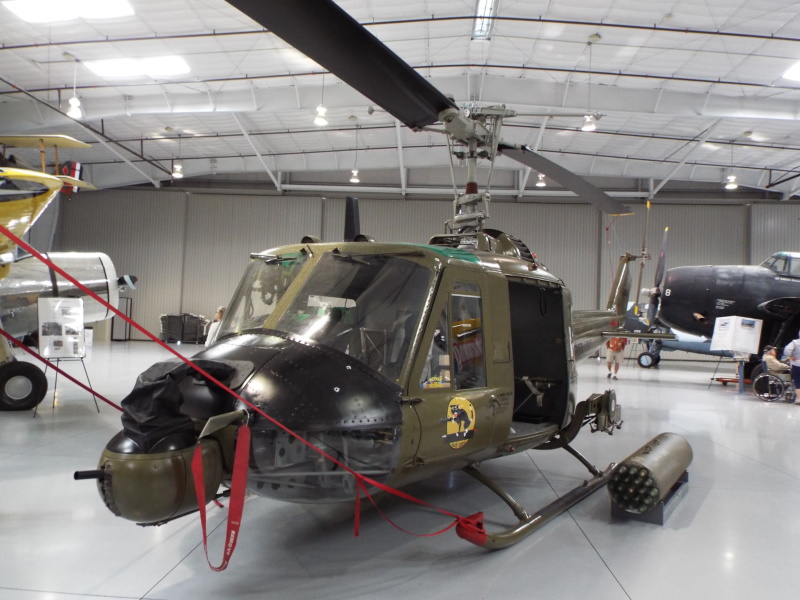
* Sources include:
* Illustrations credits:
* Revision history:
v1.0 / 01 apr 01 v1.0.1 / 01 jan 02 / Added variant summary, plus minor tweaks. v1.0.2 / 01 jan 04 / Review & polish. v1.1.0 / 01 jan 06 / General cleanup. v1.1.1 / 01 dec 07 / Review & polish. v1.1.2 / 01 nov 09 / Review & polish. v1.2.0 / 01 dec 09 / Split into two chapters. v1.2.1 / 01 nov 11 / Review & polish. v1.2.2 / 01 oct 13 / Review & polish. v1.2.3 / 01 apr 15 / Review & polish. v1.2.4 / 01 mar 17 / Review & polish. v1.2.5 / 01 feb 19 / Review & polish. v1.3.0 / 01 jan 21 / Review, update, & polish; illustrations update. v1.4.0 / 01 apr 22 / Review, update, & polish. v1.4.1 / 01 feb 24 / Review, update, & polish. (+)BACK_TO_TOP
